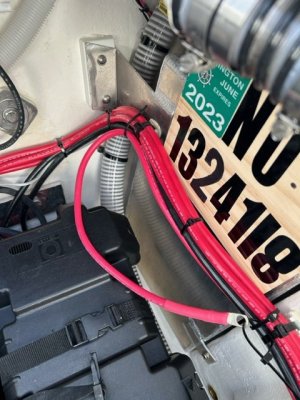Sharphooks
Well-Known Member
So I picked up a kicker for my new ride. I sort of assumed (ha ha) that the marine installer would wire it to the house battery. No, why do something logical like that? My quiet suspicion is they wired it to the starter battery to save on having to make a 4 AWG wire run. So yesterday I picked up some 4 AWG, did a nice clean swage job on the connectors, and got it all zip tied in nice and purty.
Unfortunately, I wasn’t thinking clearly and I wired it into a house power bus that was on the wrong side of the power shut off switch so it basically got wired “hot” direct to the house bank
So I had the hot end of the wire in my hand and while trying to decide where I would install the power pole so the 4 AWG wire could shake hands with the positive wire from the kicker I happened to brush the flange up against that aluminum flange below in the picture covering the bilge hose ( I believe it’s a bracket for a diesel tank that feeds the webasto).

Instant spark. I didn’t get shocked but I might as well have brushed the positive up against a negative bus bar.
Today, a bit spooked, I hooked up a multimeter to the hot end of that 4 AWG flange and wow, any piece of aluminum I touched on the transom (through-bolts for the outboard bracket etc) I got 12.50 V on the multimeter
What the heck——On a fiberglass boat? How can those flanges and bolts be grounded enough to register 12.5 V???
This afternoon I was sufficiently spooked to re-wire the kicker so now that cable will only be hot when the house switch is in the “on” position
Am I missing something? Is that normal to see 12V, especially on a fiberglass boat??? If I connected the multimeter to the outside of my 150 gallon gas tanks would it have registered 12.5V???
I’d appreciate any comments
Unfortunately, I wasn’t thinking clearly and I wired it into a house power bus that was on the wrong side of the power shut off switch so it basically got wired “hot” direct to the house bank
So I had the hot end of the wire in my hand and while trying to decide where I would install the power pole so the 4 AWG wire could shake hands with the positive wire from the kicker I happened to brush the flange up against that aluminum flange below in the picture covering the bilge hose ( I believe it’s a bracket for a diesel tank that feeds the webasto).

Instant spark. I didn’t get shocked but I might as well have brushed the positive up against a negative bus bar.
Today, a bit spooked, I hooked up a multimeter to the hot end of that 4 AWG flange and wow, any piece of aluminum I touched on the transom (through-bolts for the outboard bracket etc) I got 12.50 V on the multimeter
What the heck——On a fiberglass boat? How can those flanges and bolts be grounded enough to register 12.5 V???
This afternoon I was sufficiently spooked to re-wire the kicker so now that cable will only be hot when the house switch is in the “on” position
Am I missing something? Is that normal to see 12V, especially on a fiberglass boat??? If I connected the multimeter to the outside of my 150 gallon gas tanks would it have registered 12.5V???
I’d appreciate any comments


